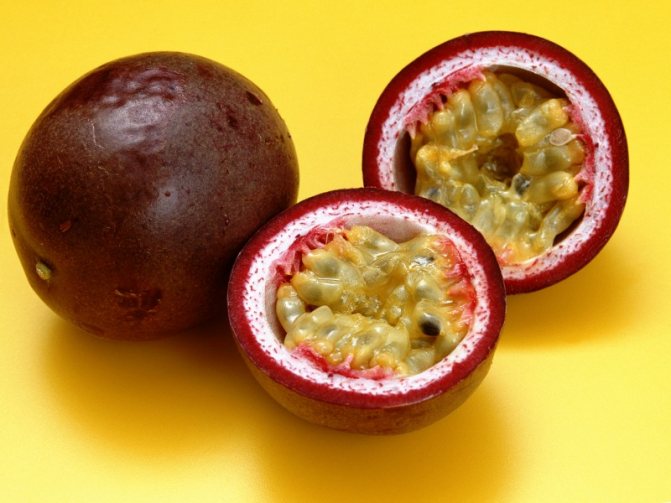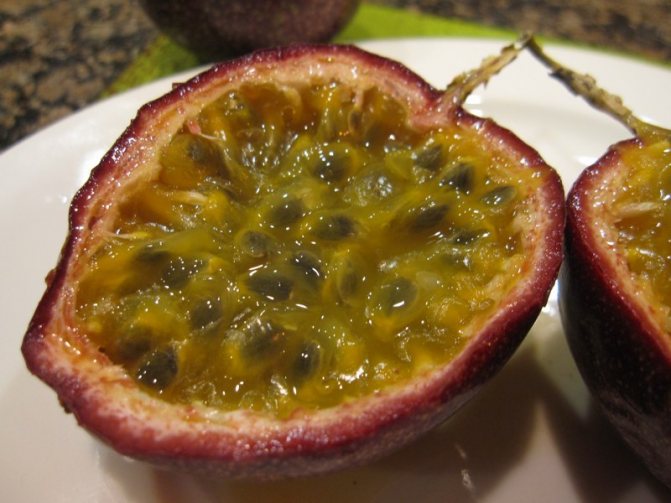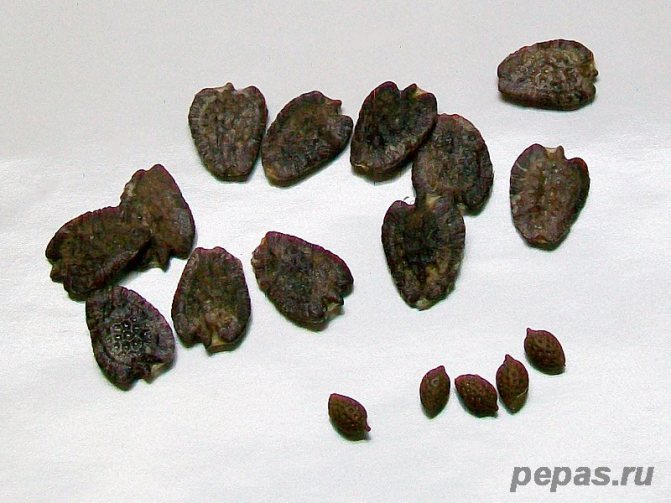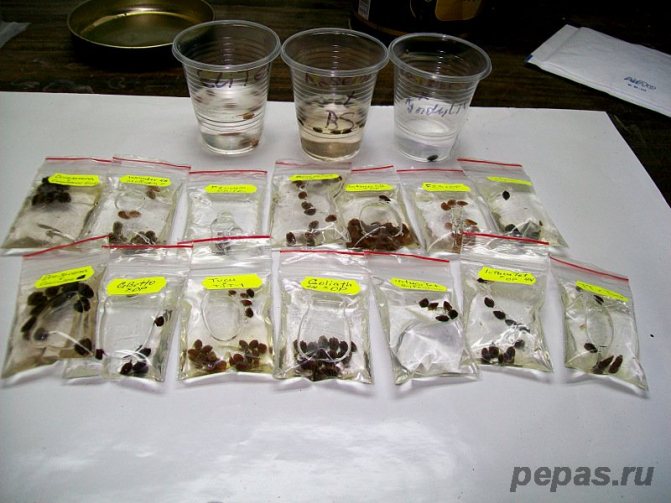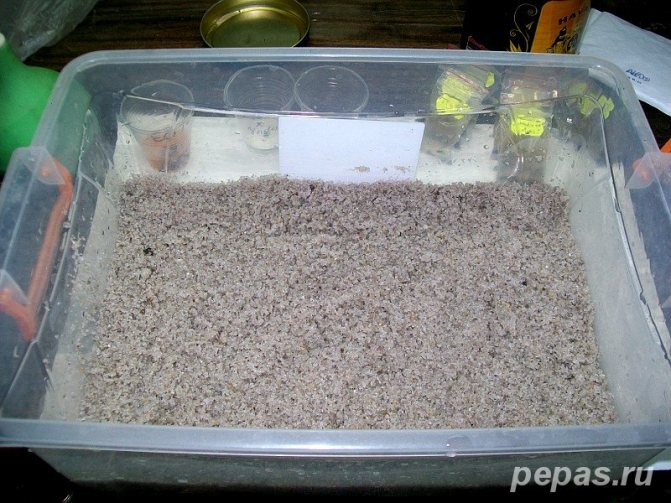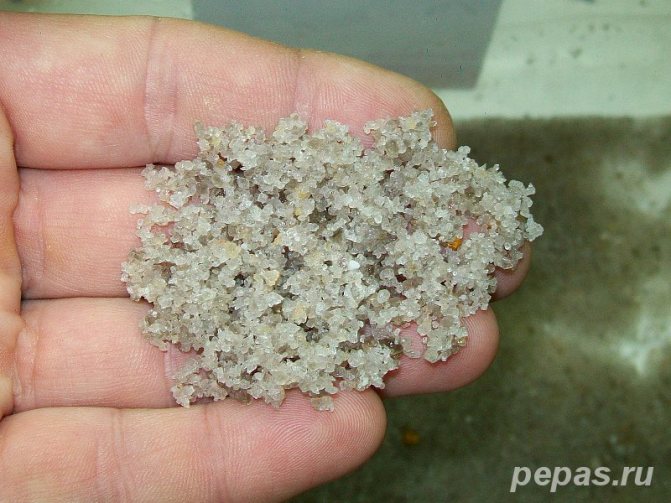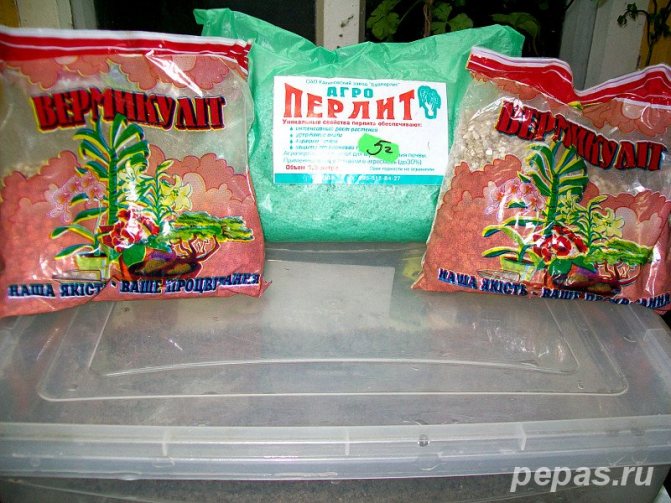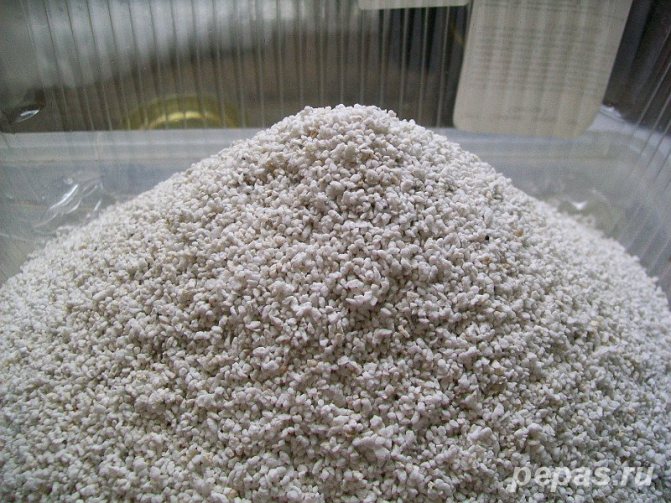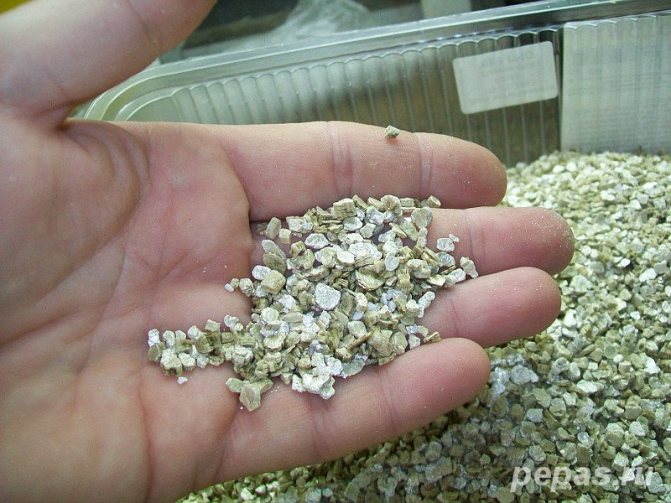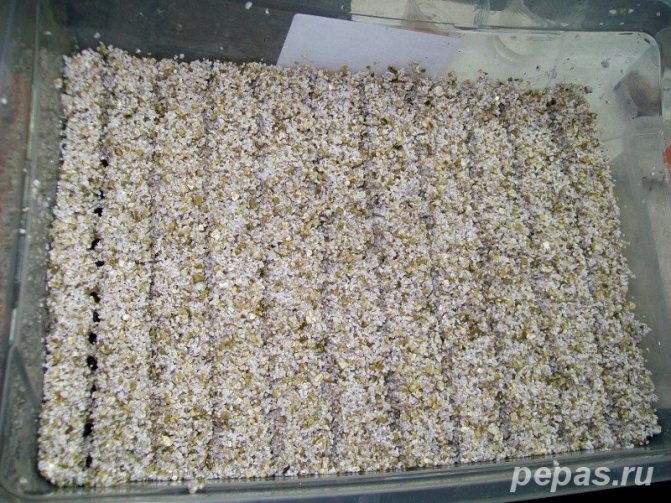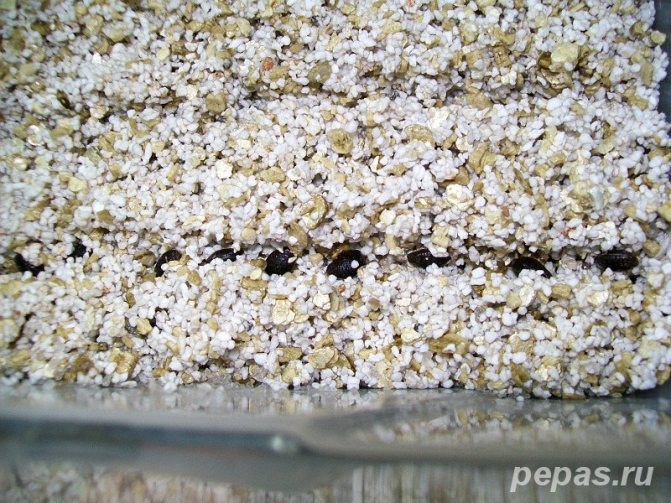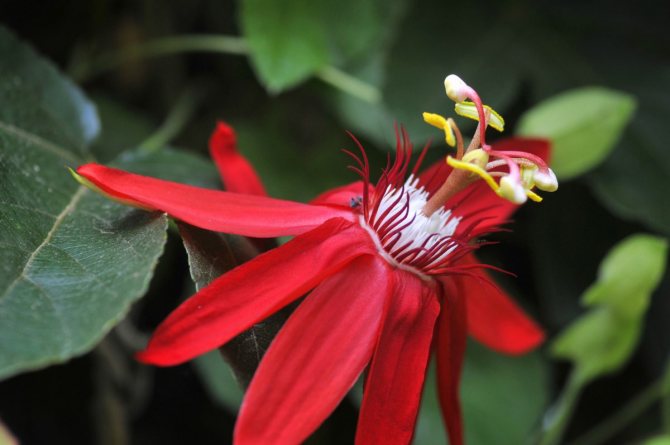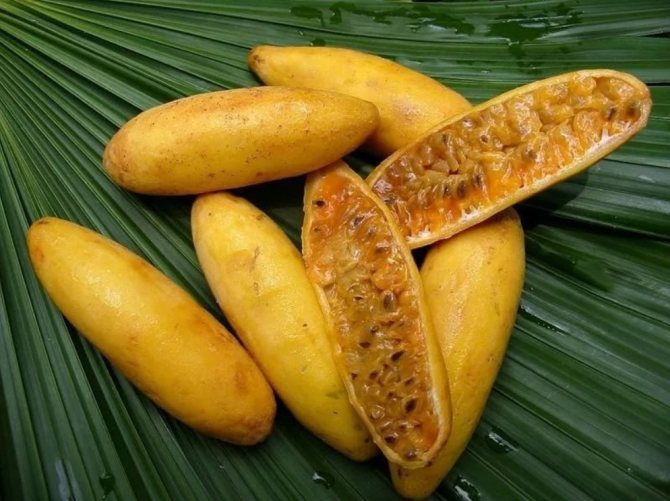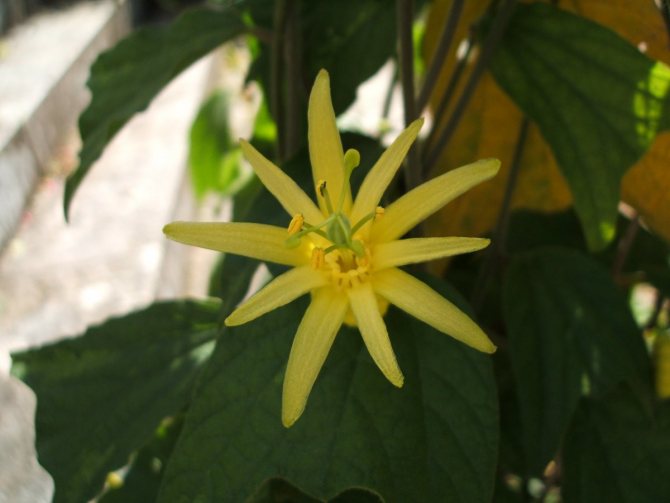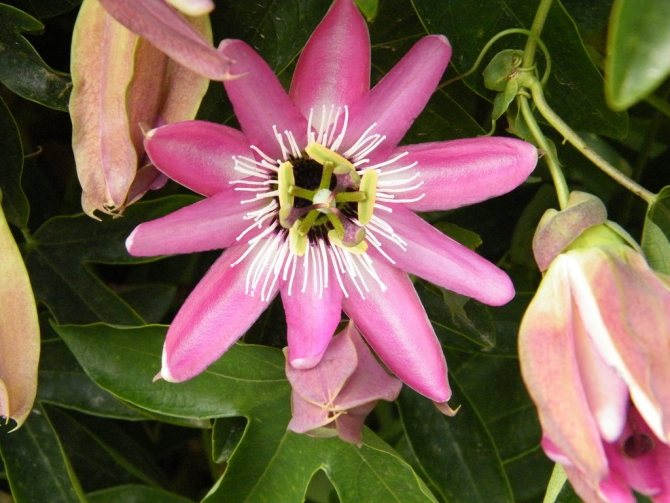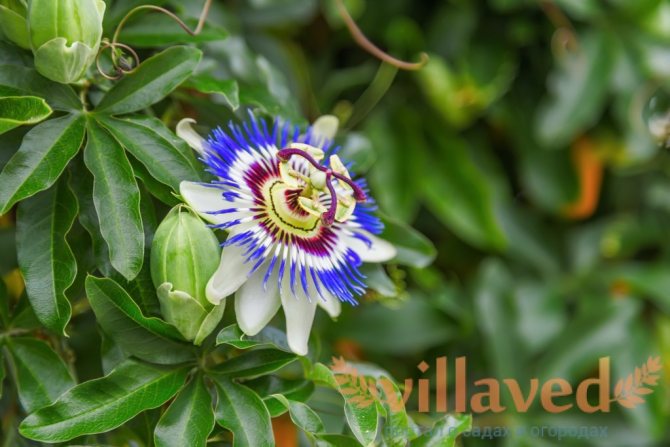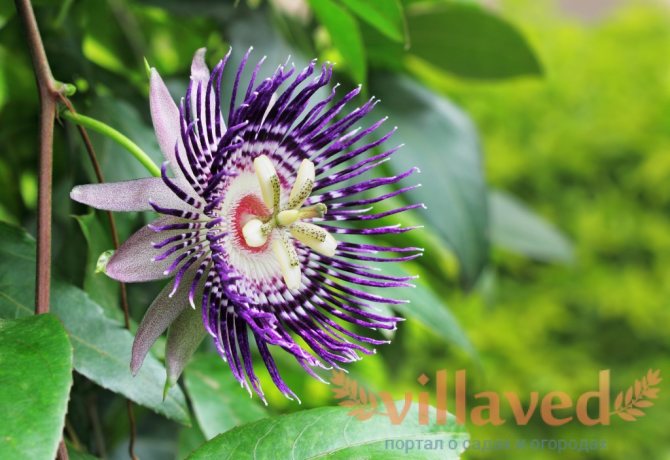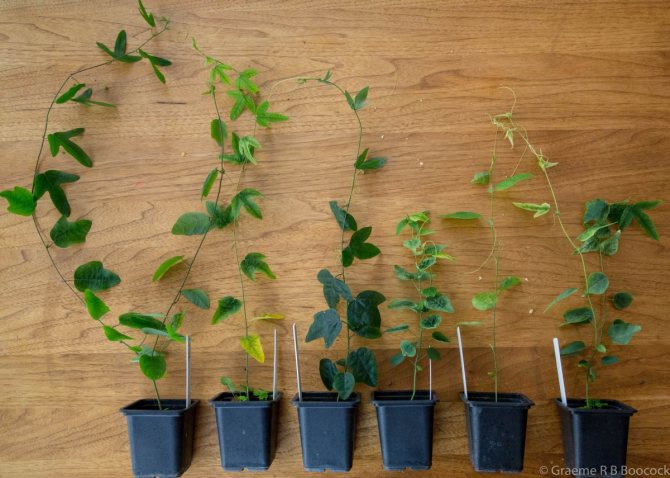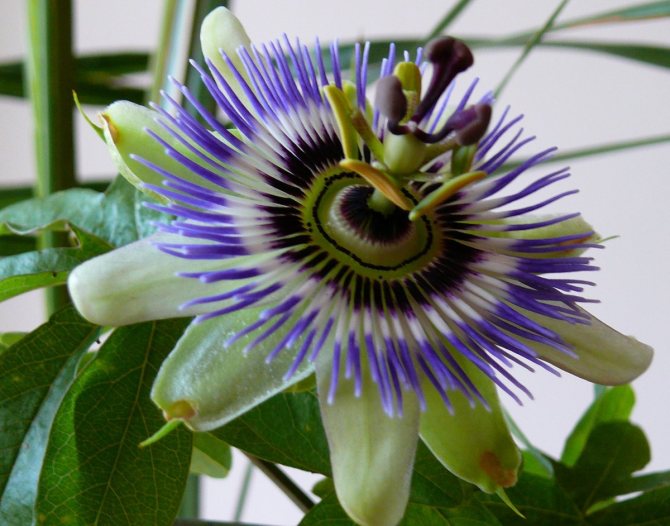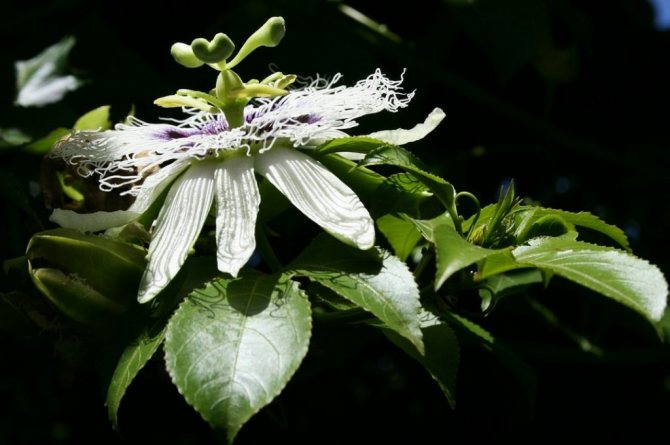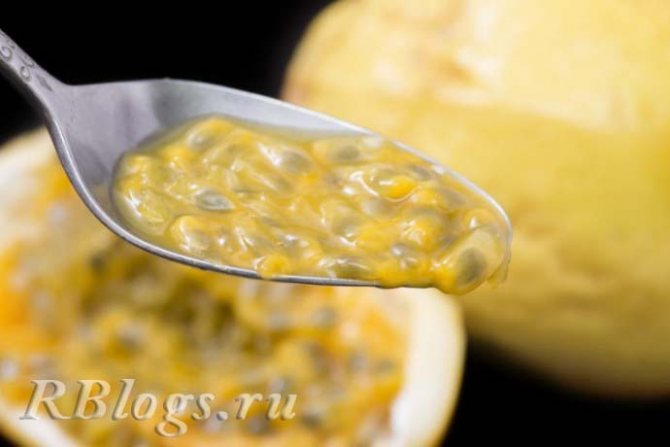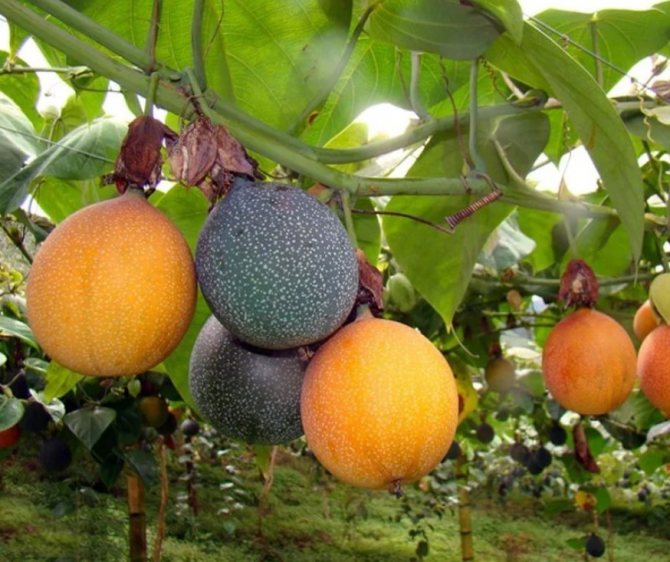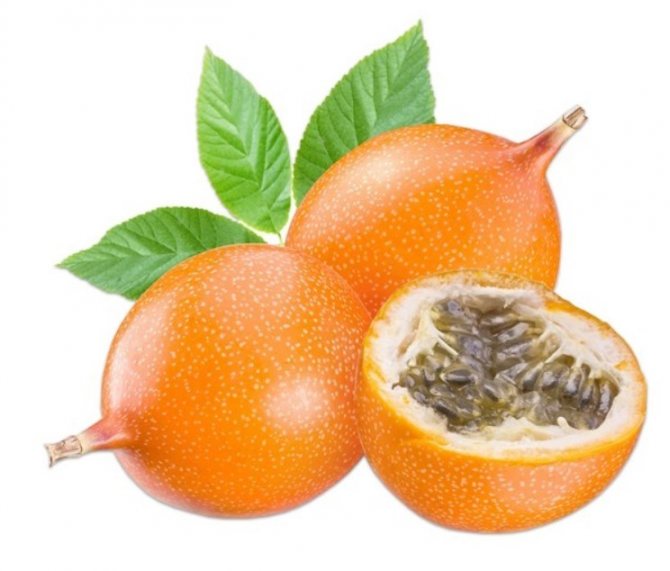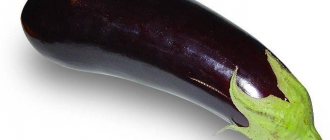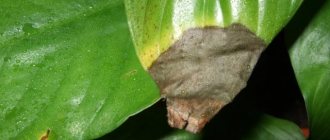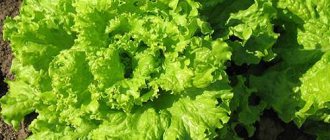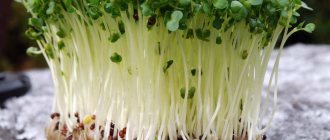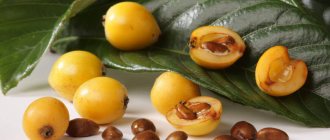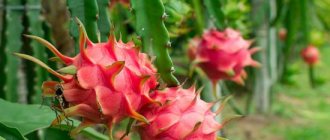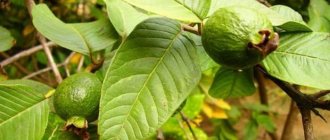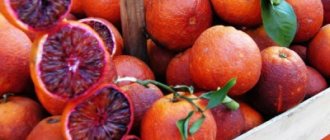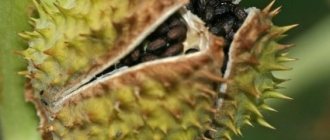Nowadays, one can rarely surprise anyone with exotic fruits. You don't have to go to Asian and Eastern countries for them. Most of the fruits are available in supermarkets. The “overseas guest” of passion fruit raises many questions. The aroma and taste of the fruit is pleasant the first time, it is eaten with pleasure by both children and adults. A slightly elongated, round fruit immediately attracts attention. If most of those who travel to exotic countries are familiar with passion fruit, then new buyers often find it bewildering. And the first question that comes to mind: "passion fruit - how is it?"
Passion fruit is widely used in cooking in Asian countries and as a dessert. It has a rich composition of nutrients, suitable for fitness diets, light snacks, a variety of menus. Dishes, with the addition of healthy fruit, become spicy and have aromatic notes. What are the benefits and harms of passion fruit? Are there any peculiarities of use? Let's find out the details.
What does passion fruit look like
The plant is cultivated in Asia, South America, Australia. Our fruit is known under different names - Purple Granadilla, Passionflower, Passionflower. In appearance, the fruit can be compared to large plums, which have a dark purple or yellowish color. They grow in length from 5 to 14 centimeters. Weight -30-60 grams. Fully ripe passion fruit attracts attention with shriveled skin, immature ones have smooth surfaces. The skin is quite elastic, reliably protecting the fruit pulp from damage.
How passion fruit grows
The homeland of passion fruit is Brazil. Later, fruit trees were cultivated in other countries. There are two types of liana plant. They differ in color - yellow and purple (purple) passion fruit. A woody perennial tree has long branches and a shallow root system. The leaves are large in size, about 22 centimeters long, are distinguished by denticles at the edges. Antennae can be purple or yellow, depending on the type of fruit. The flowers are very beautiful, they form in the axils of a young vine, and consist of five sepals. They are distinguished by bright, saturated shades.
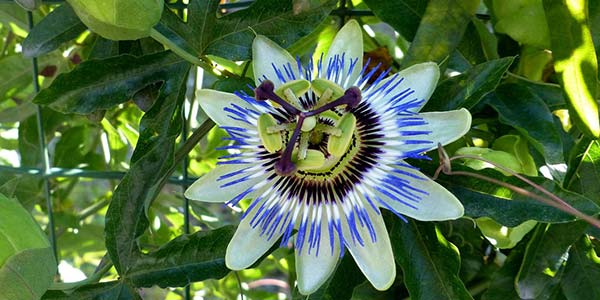
Since the plant is subtropical, it grows well at an altitude of 700 to 1200 meters above sea level. Passion fruit is sensitive to temperature changes. Ripening periods differ depending on the conditions. So, in India, it can ripen all year round.
Passion fruit season in Thailand
Traveling to exotic countries, tourists enjoy not only beach holidays, excursions, but also local delicacies. Many are interested in the ripening season of tropical fruits. The aromatic passion fruit is arousing increased interest for its fantastic taste.
Passion fruit ripening season in Thailand lasts from December to April. During this period, you can taste the healthy fruit and appreciate the benefits.
Popular types
To date, more than 600 plant species are known. Among them there are wild, garden and domestic forms. The most popular are the following:
| Passiflora variety | Description |
| Blue (Passiflora caerulea) | frost-hardy evergreen perennial with large fragrant blue-white flowers and bright green leaves with a blue tint, the fruit is an orange berry. |
| Three-lane (Passiflora trifasciata) | the front side of the dark green leaves is divided by three purple stripes, and the back is colored red-violet; flowers are white, 4-5 cm in diameter, have a strong persistent aroma, similar to lilac; fruits are small gray-gray. |
| Banana (Passiflora mollissima) or the most tender | is considered one of the most beautiful varieties: it has 12-centimeter pale pink buds and large edible golden fruits. |
| Edible (Passiflora edulis) or Granadilla (Passion Fruit) | the most common cultivar, with creamy white flowers and large sweet edible fruits reaching 6 cm in length; used for making drinks, yoghurts and sweets. |
| Laurel (Passiflora laurifolia) | A distinctive feature is large leaves, similar to laurel; the flowers are pinkish or yellowish, the fruits are edible. |
| Incarnata (Passiflora incarnata), meat-red or apricot vine | fleshy dark green leaves growing up to 10 cm in length; purple flowers, lemon yellow edible sour fruits; widely used for making teas for insomnia, epilepsy and neurosis. |
| Gracie (Passiflora gracilis) | annual with cylindrical shoots and three-lobed smooth leaves; flowers are single white-green; the fruit is a red berry. |
| Tetrahedral (Passiflora quadrangularis) | grows up to 15 m in height; has oval bright green leaves, large (up to 15 cm) of a pale purple hue, buds and juicy sweet large fruits reaching 30 cm in length. |
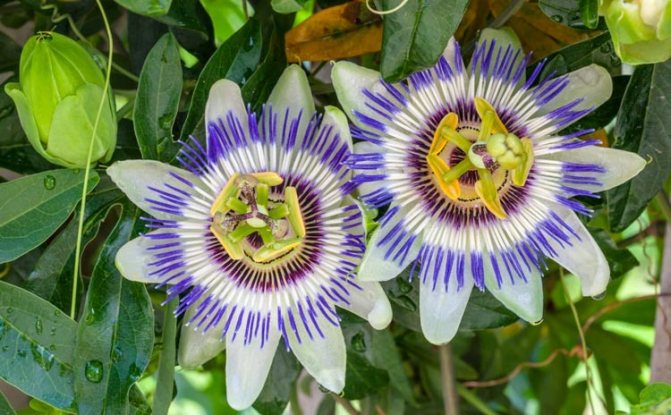

Passiflora Caerulea
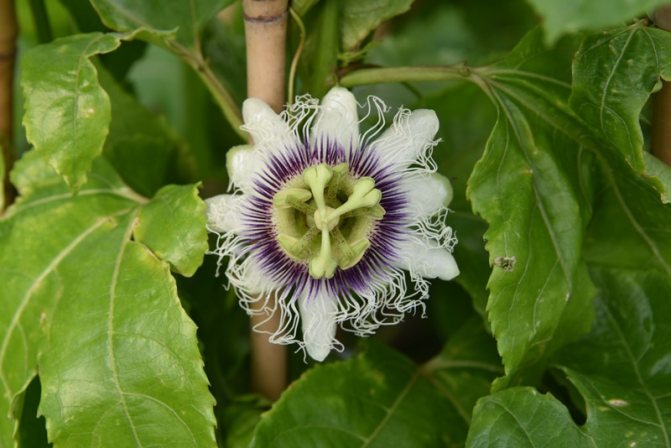

Passiflora Edulis
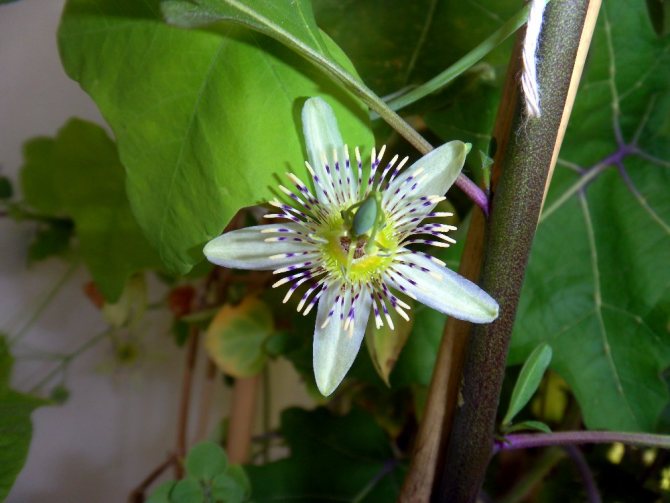

Passiflora Gracilis
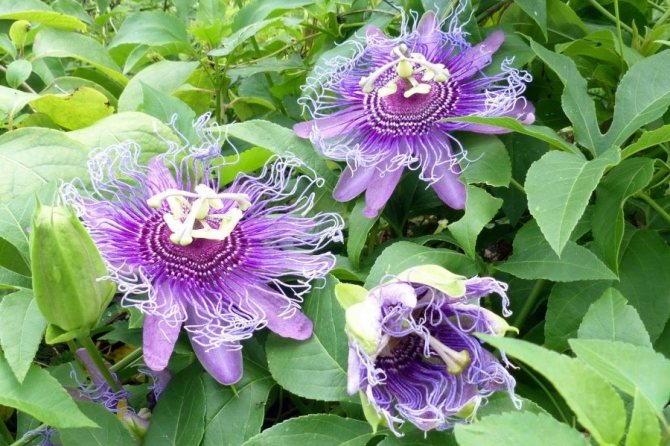

Passiflora Incarnata
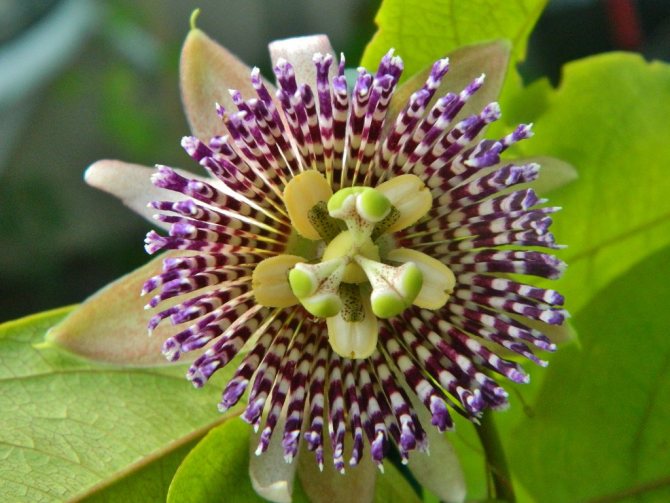

Passiflora Laurifolia
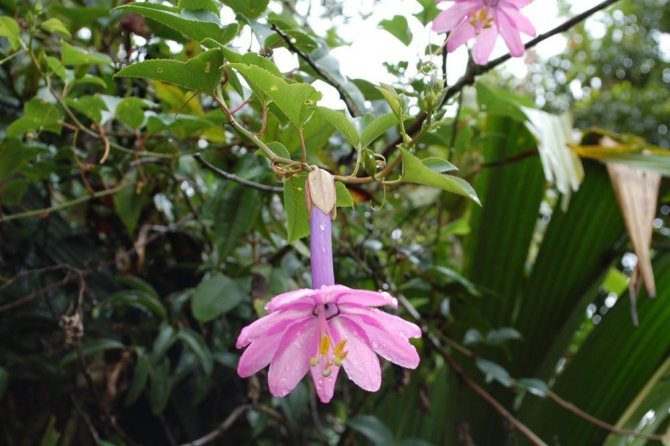

Passiflora mollissima
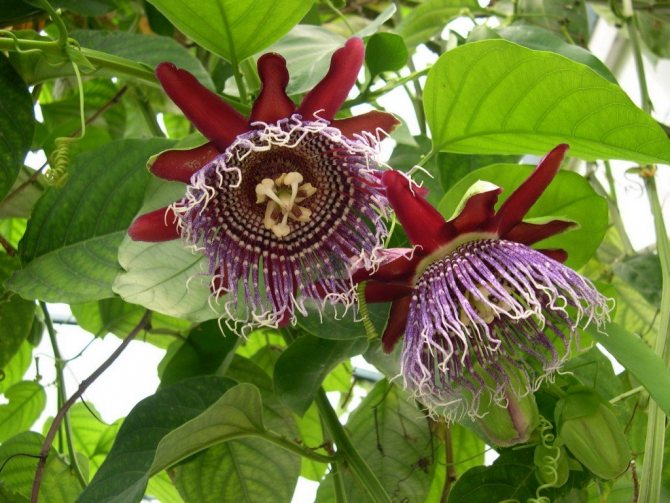

Passiflora Quadrangularis
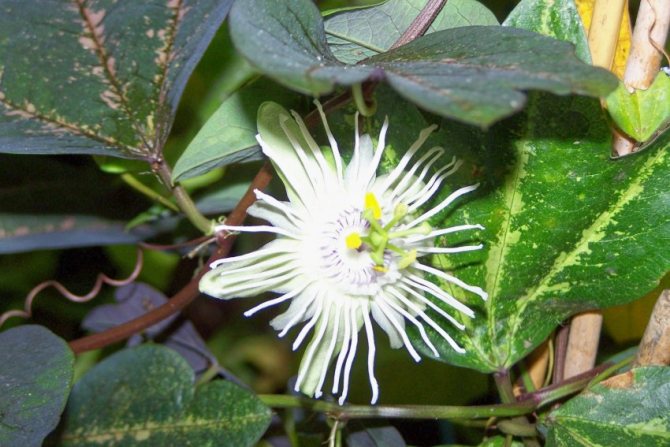

Passiflora Trifasciata
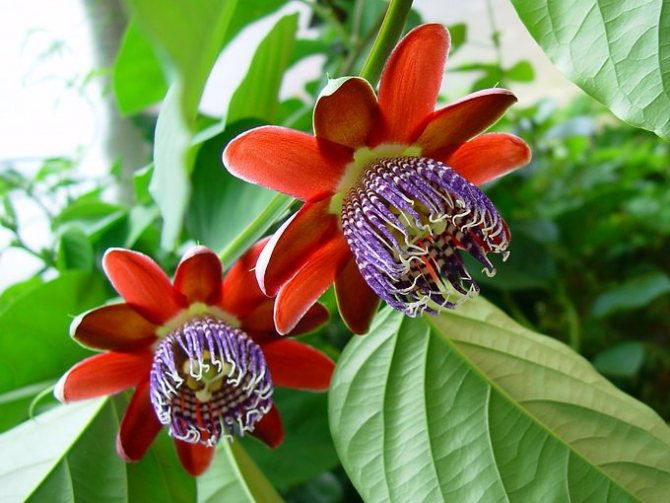

Passiflora alata
How to eat passion fruit
An inexperienced tourist does not know how to properly consume an unusual fruit. In fact, everything is simple.
- Passion fruit is thoroughly washed under running water.
- Cut into halves.
- The pulp is selected with a spoon (up to a white layer on the peel).
You can swallow the useful mass without chewing, at the same time with small bones. Passion fruit peel is quite bitter, so it is recommended to throw it away.
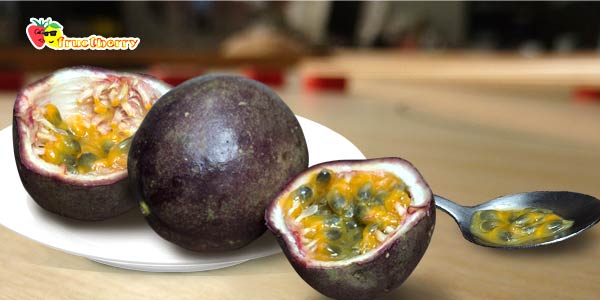

How to choose passion fruit
Yellow or green fruits are less sweet. Used for making juices. However, you can safely buy immature, green passion fruit. The fruits ripen at room temperature.
Cultivation
Difficulties
... It is easy to grow, but pruning is required regularly (if you do it).
Sowing
... Indoors in early - mid-spring, 2-3 seeds per pot with a diameter of 8 cm, for germination in a heated propagator at a temperature of + 20-25 ° C or on a well-lit windowsill. If all three seeds have sprouted, remove one seedling. Transplant in pairs into larger pots as needed.
Landing
... Plant in a 38-45 cm diameter container filled with a mixture of loamy compost and all-purpose compost and sand. Or on a greenhouse bed (the soil must be pre-fertilized with a large amount of well-rotted compost or manure - nutrients are needed in abundance for a rapidly developing plant). Like any liana, passion fruit needs support, for example, a 2 x 2 m lattice or a pyramid. Tie the stems to the support, and then the plant will become fixed on it by itself, with antennae, as it grows.
Care
... Water well during the growing season. Feed with liquid tomato fertilizer weekly. Pollinate by hand.
At the end of winter, prune any flexible stems from the previous summer, two buds away from the main shoots that are anchored to the support. Plants can be fan-shaped.
Cleaning
... Harvest fruits from late summer when they turn dark purple in color. Wait until they wrinkle slightly, then cut them off with a pruner.
Storage
... The fruits can be stored for a week in an ordinary fruit vase.
Passion fruit flavor
It is quite difficult to describe the taste of passionfruit, it is individual and does not resemble any particular fruit. Rather, it resembles a mixture of several fruits and berries at the same time. Ripe passionfruit is sweet, slightly sour and can be slightly tart.For some people it is a mix of peach, gooseberry and sea buckthorn, others feel a mixture of kiwi and apricot strawberries in one bottle. In any case, the aroma and taste of the unusual exotic will not leave indifferent a person who has tasted the juicy passion fruit for the first time.
Reproduction
Seeds
The optimal time for sowing is February-March. This breeding method requires:
- prepare the seeds - lightly rub them with sandpaper, and then hold them in hydrogen peroxide (3%), in fresh citrus juice, or soak them for a couple of days in warm water;
- disinfect the substrate, cool it and moisten it;
- sow, cover with foil;
- ventilate daily for 5 minutes, spray the soil with a sprayer if necessary;
- contain at a temperature of 25 ° C;
- after the appearance of the first shoots, remove the film;
- when there are 2 leaves on the shoots - transplant to a permanent place.
By cuttings
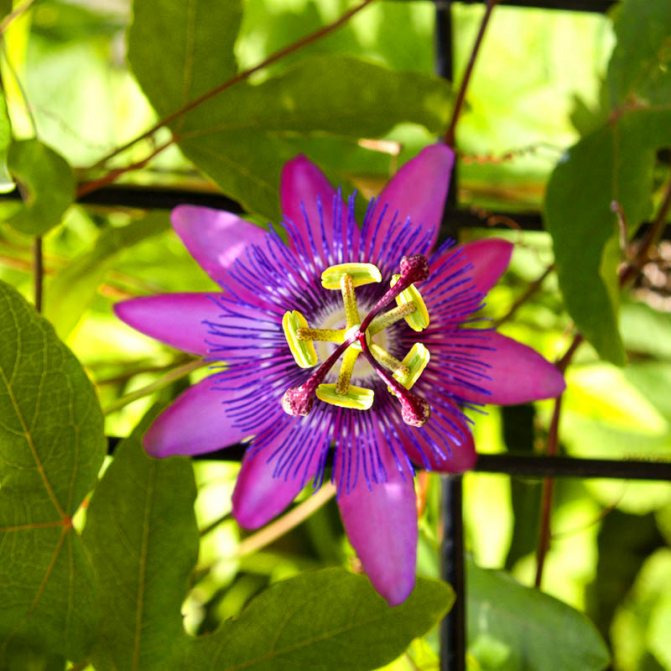

For this method, lignified cuttings are cut in the summer. Those that have 2 nodes and at least 4 leaves will do. Put them in water with a piece of charcoal. The roots will appear in 1.5-2 months. During the entire period, the water must not be changed.
When grown outdoors, passionflower is used for vertical gardening - the plant quickly braids around gazebos, fences and other supports. In addition, brightly fragrant flowers will become the highlight and pride of any garden. Interesting compositions of indoor plant species will add an exotic touch to the interior of the apartment.
How to store passion fruit
To bring the passionfruit safely, it is recommended to wrap it tightly in paper or place it in a small basket.
Unripe fruits will ripen at room temperature in two days. Ripe ones must be placed in the refrigerator. The shelf life is 7 days.
For long-term storage of fruits, freezing is useful. To do this, the passionfruit pulp is mixed with sugar. Placed in plastic bags and frozen. Passion fruit can be stored in this way for 12 months. At the same time, the beneficial properties of the fruit are preserved.
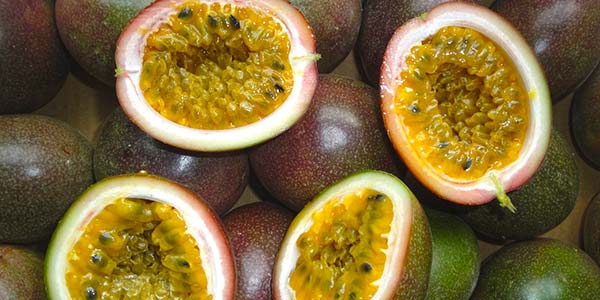

Planting and leaving
Planting and transplanting
Optimal for passionflower will be a soil consisting of sand, peat, leafy and soddy soil, taken in equal proportions.
The capacity should be chosen not too large, otherwise flowering may not come. When planting, you do not need to bury the sprout. In the first two weeks, the passion flower will need greenhouse conditions: for this, you just need to cover the shoot with a glass jar.
If passionflower is grown as a perennial, then it needs a transplant. In this case, before the procedure, the vine should be cut off by about 1/3 of the total length.
A transplant is carried out in the spring:
- for young plants - annually;
- for adults - every 2-3 years.
In the process, it is important to preserve the earthen ball, therefore it is better to use the transshipment method. Passion flower also needs strong support for normal growth.
Placement and lighting
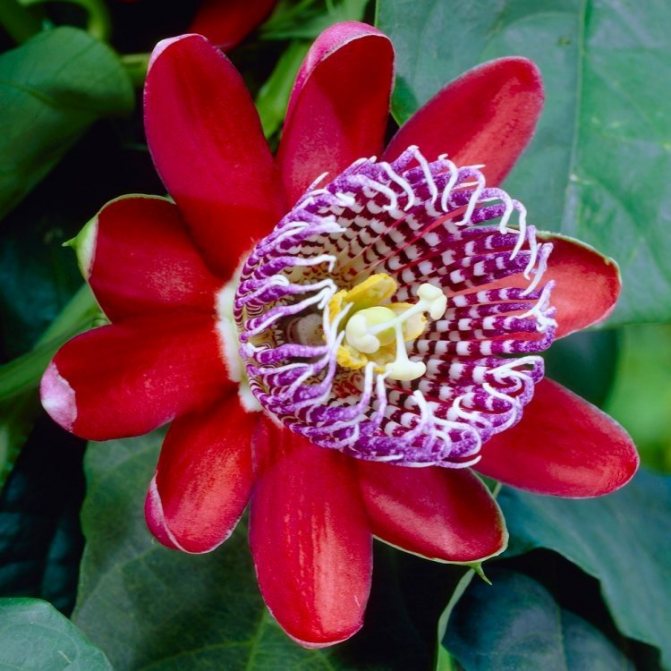

Passionflower is a light-loving plant, so the best place for it would be windows on the south side of the house or an area with bright diffused light in the garden.
The air in the room should always be fresh, but at the same time drafts and sudden changes in temperature are unacceptable. In the summer, the passion flower should be taken out into the fresh air - this way it will bloom better.
Temperature
When keeping a flower at home:
- in summer, make sure that the temperature in the room does not exceed 30 ° C;
- in winter, transfer to a place where there will be no more than 10-14 ° C.
When grown in the garden: in the fall, before the temperature drops below 15 ° C, the passionflower must be moved to a cool room (13-16 ° C). In the event of a violation of the temperature regime, the passion flower will begin to lose leaves and become bald. The only exceptions are frost-resistant varieties, which for the winter are enough to cover with dry leaves, straw and special material.
Watering and humidity
In the spring-summer period, watering should be abundant and regular: the soil should not be allowed to dry out.In this case, the excess liquid from the pallet must be drained. The flower needs high humidity, so it should be sprayed daily in the evening. In extreme heat, once a week, it is recommended to rinse the passionflower under the shower with warm water. By winter, watering should be reduced to 1 time in 10 days, no need to spray.
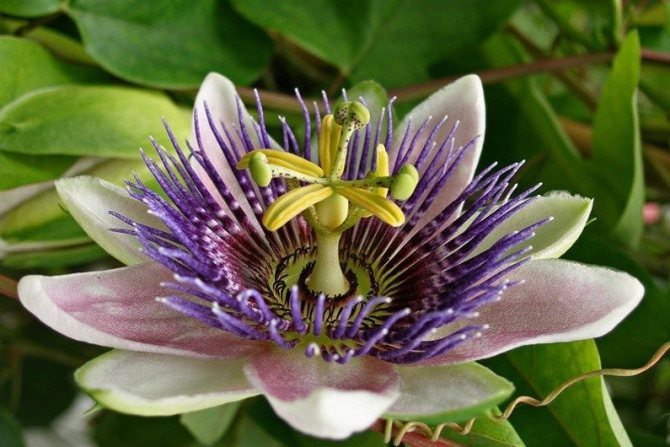

Top dressing
- From February to September, feeding should be carried out 2 times a month. For this, you can use both organic and ready-made mineral fertilizers.
- From April to September, it is recommended to additionally feed passionflower by the foliar method once every 1.5 months.
Before the procedure, the plant must be watered, otherwise the roots may suffer. During the rest period (in winter), in the presence of diseases, as well as when placing a flower in unusual conditions, it is not worth fertilizing it.
Pruning
Pruning of passionflower should begin in the second year of life: before that, the main shoots are formed, which will later form the "skeleton" of the plant and ensure the formation of buds.
The procedure is carried out:
- in spring: old secondary shoots are cut by 1/3;
- in summer: young growth is removed at the base;
- in autumn after flowering: long bald secondary stems are cut off, and the rest are shortened by ¾.
Diseases and pests
Passiflora can be settled by:
- aphid;
- spider mites;
- mealybugs;
- thrips;
- whitefly.
Therefore, it is important to carry out regular preventive examinations and ensure proper plant care. If parasites have appeared, insecticides will help get rid of them: Fitoverm, Aktellik, Aktar, Inta-vir.
In addition, passion flower is susceptible to some incurable diseases: ring, brown, bacterial spot, root rot, scab, late blight, fusarium. In case of infection, it is necessary to get rid of the plant and the container in which it was located.
Composition and calorie content
Exotic fruits are a real storehouse of vitamins, macro and microelements:
- carotenes;
- manganese;
- vitamins A, C, E, H, K, group B;
- ash;
- sodium;
- dietary fiber;
- amino acids;
- magnesium;
- polyunsaturated fatty acids;
- potassium;
- chromium;
- iron;
- aluminum;
- organic acids;
- phosphorus;
- iodine;
- antioxidants;
- iron;
- ascorbic acid;
- flavonoids;
- sulfur;
- copper;
- fructose;
- folic acid;
- fluorine;
- calcium;
- pectin.
A particularly high content of potassium and iron in passionfruit. The calorie content of 100 g of the product is 70 kcal.
Vitamins
Thanks to the vitamin composition, the healthy fruit enhances immunity, protects the body during the season of colds and infectious diseases.
Folic acid is beneficial during pregnancy. B vitamins help fight stress.
Minerals
Potassium is an important trace element for the cardiovascular system. Passion fruit is a source of iron, an essential element for hematopoiesis and the formation of hemoglobin.
The fruit is supplemented with other minerals, the exotic fruit becomes indispensable and useful in dietary and healthy nutrition.
The scheme of growing passionfruit from seeds, seeds, cuttings
Passion fruit (edible passionflower) is a climbing plant from the Passionaceae family. This is a magnificent fruit known all over the world, which is very much loved due to its delicate sweet pulp, used as a dessert or as a base for preparing drinks.
At home, this plant is grown not so much for fruit as for decorating the house, because passion fruit blooms exceptionally beautifully, and it is worth the effort spent on it.
Since we are talking about growing passionfruit at home, the plant will happily "live" to adulthood when grown in any of the following ways.
Ripe passionfruit
Seeds.
To really achieve a worthwhile result, you need to use only fresh seeds: dry ones may not even sprout.Therefore, a couple of days before the planned passion fruit planting, buy fresh ripe fruit from the store and select a few seeds. Spread them out on a cloth and rub gently until the juice bags open. After that, you should rinse the seeds and dry them. Then wash and dry again (never in the sun).
Now you can start preparing the container for growing passion fruit: it should not be very deep. Pour the prepared soil mixture there (garden soil, sand, compost in a ratio of 1: 1: 1). Make small furrows in the soil, keeping a distance of about 5 cm between them. Lower the seeds into the furrows at a distance of about 1 cm from each other and sprinkle them with a thin layer of soil. Water the seedlings and leave in a warm place. Moisten the soil periodically. When the shoots have reached a height of about 20 cm, you can transplant to a permanent place.
Cuttings.
This growing method is very simple and can give the desired result in most cases. So, first of all, prepare a deep growing container. The soil mixture for growing cuttings should consist of fine-grained sand and fertile soil (3: 1). The soil and sand should be thoroughly mixed so that the growing mixture is uniform.
Advice. Do not worry about using such a specific soil mixture (after all, it practically does not retain moisture). The fact is that passionfruit cuttings at the time of planting do not have roots and the main goal at the first stage of cultivation is considered to strengthen the aerial part of the plant, respectively, it should receive the lion's share of moisture.
The stalk must be chosen correctly: only young shoots with at least 3 buds are cut off (the cut is done obliquely above the lower bud). The soil is prepared in the same way as for growing by seed. The stalk should be planted in a container immediately after it has been cut. The cuttings must be kept in a humid environment. You can create such an environment with the help of an impromptu greenhouse: you can make it from a box-shaped frame covered with plastic film.
Young sprout of passionfruit
The created camera is moved to a sunny place with high humidity. The cuttings should take root in just a couple of weeks. After that, you can transplant to a permanent place.
From the bone
... This method is quite exotic and requires a lot of effort (at least, patience will probably be required). The fruit is thoroughly cleaned, the bone is freed from the pulp, after which it is thoroughly dried. The seed is not planted very deeply into the soil. The seedling is watered. The container with the planted bone should be in a warm place with high air humidity. Thus, the passion fruit will provide optimal conditions for the emergence of the sprout.
Why passion fruit is useful
When processed, the fruit does not lose its beneficial properties, dried fruits are just as useful as fresh fruits. The influence of a fruit rich in vitamin and mineral complex is manifold.
- Improves memory. Stimulates the body with increased mental or physical stress.
- Natural aphrodisiac.
- Prevents the development of vitamin deficiency.
- Useful for lowered immunity.
- It has antiviral, diuretic, immunostimulating, regenerating, anti-inflammatory effects.
- Prevents the development of hypertension, atherosclerosis.
- Lowers blood cholesterol levels.
- Lowers blood sugar
- Normalizes the activity of the organs of the gastrointestinal tract. Strengthens intestinal motility, removes toxins from the body.
- Strengthens the walls of blood vessels.
- Normalizes metabolic, digestive, water-lipid, alkaline metabolism.
- Increases resistance to infectious diseases.
- Removes excess fluid from the body.
- Preventive remedy for cancer.
- Passion fruit is beneficial for visual acuity.
- Purifies the blood.
- Regenerates cells quickly.
- Strengthens the cardiovascular system.
Watch this ...
In the greenhouse, passionfruit is damaged by whiteflies, aphids and red fruit mites, although rarely. Aphids are carriers of the cucumber mosaic virus, due to which the leaves become covered with yellow specks and the plant loses its strength. There is no cure for this disease, so dig up the plant and destroy it.
Passion fruit is an unusual plant that came to our latitudes from the hot humid tropics. Nevertheless, this one has taken root well with us, so many gardeners are happy to take on growing it at home. Further, about the features of growing passionfruit (seeds, pits, cuttings), as well as caring for the plant at home (photos and instructions are attached).
Areas of use
The passionfruit fruit has found widespread use in various fields.
In cosmetology
Masks, lotions, scrubs are prepared on the basis of the fruits. The products are suitable for delicate skin. Protect from UV rays. They have a rejuvenating effect. Get rid of acne.
Especially popular is passionfruit oil, added to the manufacture of face and body care products. The component has regenerating, regenerating, moisturizing properties. In its pure form, it is an excellent massage agent.
Dietetics
Since passionfruit is low in calories, it is suitable for dietary nutrition. The body receives all the nutrients. And there is no need to fear for the figure.
Cooking
The most common use of passion fruit is making healthy juices, cocktails, and drinks. The fruit will complement the taste of baked goods, seafood, desserts, fish, liquor, rum, chocolate.
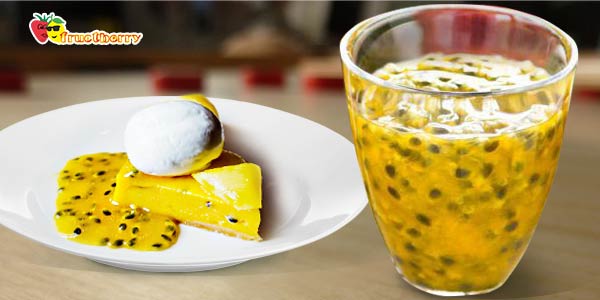

Growing conditions for indoor passionflower
It is not easy to find a really comfortable place for passionflower in the rooms. This plant belongs to the extremely light-loving and in living quarters can only settle on window sills. And the requirements for a cool wintering do not simplify the selection of a place for it. Before starting a indoor passionflower, it is worth evaluating the conditions that can be provided to it.
Passifloras are easily formed, although not the most flexible vines. They cannot be grown in bush form, with overhanging, spreading shoots, in pots on high stands. But on the other hand, it can be used for walls or trellises, formed on supports. Passion flower is especially good on arches and round supports, but it looks good on other types of bases and frames as well.
Lighting and placement
For passionflower, you need to find really bright places. She is not afraid of the direct sun. In the summer at noon, the rays can be too scorching even for its leathery leaves, but usually in southern locations, the vine feels good.
Even the slightest shading leads to stretching of the plant, shrinking of leaves, lengthening of internodes and a corresponding deterioration in flowering. A plant needs good lighting all year round, even during the winter, regardless of whether passionflower combines indoor and garden culture or is grown only as a houseplant.
To place passionflower, you should not choose rooms and even north-facing balconies. On the southern balconies (but not on the southern windows), she will only need diffuser screens in the summer. Due to its sensitivity to exclusively natural light, it is impossible to grow this liana in the interior, and not on the windowsill. Passionflower is suitable for winter gardens.
Temperature control and ventilation
From spring to autumn, passionflower requires a warm, comfortable place with temperatures higher than + 21 ° C. With a drop in temperature, and with fluctuations in lighting, too, the plant may stop blooming. It is a plant that is demanding on environmental stability and thrives in living rooms or on warm days.
If passionflower combines garden and indoor culture, its dependence on the weather is more pronounced. On cloudy days, the liana does not open its flowers and demonstrates its "discontent" with all its appearance.
The key to a beautiful flowering of passionflower and the main condition for success in growing this vine, of course, is a cool winter. Unlike some competitors, passionflower will not be content with a slight drop in air temperature: it needs a really contrasting cold winter with a temperature drop of at least 10 degrees. The optimal temperature for passionflower is considered to be from 6 to 8 degrees Celsius, it is better to limit the maximum values in winter to 12 degrees.
Fresh air access, high-quality, regular ventilation of rooms are important for this vine no less than the optimal temperature values. Passionflower cannot withstand stagnant air even in winter when kept in the cold.
Passionflower feels great outdoors. It can be moved to the garden for the summer or at least to the balcony. At the same time, it must be protected from drafts in rooms, especially during the period of cool wintering.
How much is a Passion Fruit in Russia
You can buy tropical fruits in specialized stores that supply products from different parts of the world.
| Name of product | price, rub. |
| Fresh granadilla (Colombia), 100 g | 250 |
| Frozen passion fruit puree Les Fruits (France), 1 kg | 860 |
| Dried passionfruit (Vietnam), 100 g | 330 |
| Dessert sauce of passionfruit and mango Food Specialize (Thailand), 150 ml | 260 |
Granadilla has been successfully used for decorative purposes. Designers offer their clients to plant fruit as a garden (for the southern regions of Russia) or indoor plant. With good watering, a vine, for example, blue passionflower, grows rapidly, creating a system of vertical gardening of blank walls, gazebos and interior items.
Procurement and storage of medicinal raw materials
For medicinal purposes, passionflower herb is used, an extract of passionflower incarnate is made from it. Procurement of raw materials goes through 3 stages:
- For the first and second time, the central parts of the plants are cut off to allow the lateral shoots of the vine to develop.
- The last stage coincides with the ripening of the fruit. At this time, you can cut the vine at the root. In the spring, the plant will fully recover, letting out young shoots.
You need to dry the grass in a dryer at a temperature of sixty degrees. You can store finished raw materials for no more than 2 years.
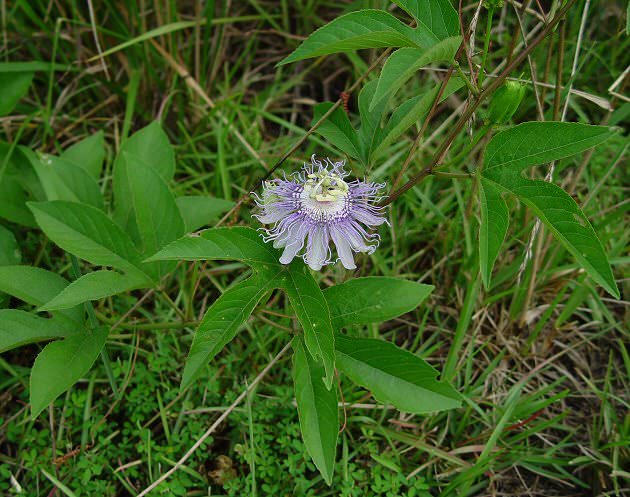

Contraindications and side effects
It is generally safe to use Passion Flower formulations in moderation. It should be taken no more than two months. Then be sure to take a break for two or three weeks. And only then can the reception be resumed again.
Some side effects may include:
- Dizziness
- Confusion of consciousness
- Change in consciousness
- Nausea
- Vomiting
- Drowsiness
Heart rhythm failure when taken in high doses and over a long period.
If you notice these symptoms, stop taking the drug immediately and see your doctor.
Passionflower is not recommended during pregnancy, as it contains substances that can cause the uterus to contract.
You should not drink passionflower and preparations with it while breastfeeding, as there is no scientific evidence on its effect on a child and how safe it is for infants.
Do not take passionflower while taking medications for high blood pressure and antidepressants.
It is forbidden to take drugs with passionflower before surgery or research using anesthesia.
Passionflower should be avoided by people who have a tendency to have low blood pressure, as the antihypertensive activity of passionflower can lower blood pressure levels to dangerously low levels.
Multiple cups of passionflower infusion or tea may cause drowsiness.
Passion flower extract can inhibit blood clotting.This may not be entirely dangerous for people who have a tendency to form blood clots, but it is dangerous for people with normal blood clotting, as it can lead to hemorrhage.
Passion flower care precautions
Passionflower can bring both benefits and harm to human health. All parts of passionflower, except its fruit, can cause paralysis and hallucinations.
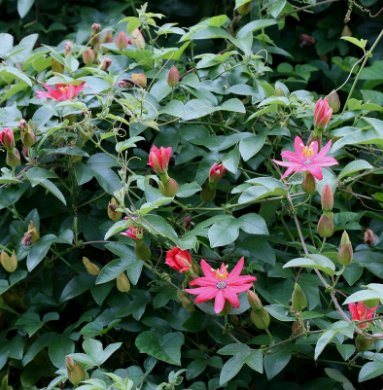

Preparations containing elements of this plant can suppress the transmission of nerve impulses in the brain and spinal cord, increase the respiratory rate, and reduce the excitability of the nervous system.
For many insects, the leaves and shoots of the plant are poisonous.
Recipes for use in traditional medicine
There is a different way of using passionflower herb for every human health disorder. However, it must be properly assembled and prepared before use.
Important!
It is necessary to pluck the plant only in the phase of active flowering, which will soon develop intophase of fruitfulness.
During the summer, several herbs are collected:
- shoots up to 60 cm long - this stimulates the development of lateral branches;
- during the formation of buds - the most developed are collected;
- during active flowering, the entire upper part is torn off, while only rhizomes remain for the winter.
The grass needs to be dried
- for this, you can place it in an oven or oven with a temperature of 50-60 ° C. Or just leave it in a warm room to dry for several weeks. To do this, you can tie the branches into bunches and hang them on the clothesline. The inflorescences are laid out on paper or cloth. You can store it for several years.
When the raw materials are prepared, we begin to use them for medicinal purposes.
Tea
To prepare a hot drink, you will need 1 teaspoon of inflorescences, which you need to pour 300 ml of boiling water. Cover the container with a lid and leave for 10 minutes. The infusion is advised to be consumed a couple of hours before bedtime. It helps to calm down, relax and fall asleep easily.
Alcohol tincture
Tinctures that contain alcohol are best used for treatment of wounds and cuts,
as well as after insect bites - they will help soothe the skin, and at the same time disinfect the sore spot. 100 ml of vodka requires 2 tbsp. tablespoons of a dry plant. Insist for several weeks in a dark, cool room. If taken orally, then the dosage is 20-40 drops per half glass of water.
You can also prepare infusions without adding alcohol. They are used to get rid of alcohol and drug addiction. Cooking in this way: fill the leaves with hot boiled water so as to completely cover them. The infusion should cool and stand for at least a day; then it must be expressed through cheesecloth so that there is no admixture of grass. Then you can take a teaspoon three times a day.
Treatment fees
The most common and beneficial herbal tea is from lemon balm,
mint
and
passionflower
... To cook like this: a glass of boiling water on a tablespoon of dried and chopped herbs. Insist until it cools down. Take a third of a glass a day.
Important!
Do not take medicinal herbs with high blood pressure together with pills.
It will help with pressure, gastrointestinal disorders, sleep problems, and will serve as an anti-inflammatory lotion for minor wounds. Also, for a mix with passionflower, they are perfect hops, St. John's wort or hawthorn.
Seedling container
The choice of dishes in which the seeds will initially be planted is individual. Some prefer individual cultivation, others - mass. In accordance with the choice of capacity, the number of seeds that will be planted also depends. The most common uses are pots, disposable cups, or food trays.
One of the most popular and reliable methods of growing passionfruit is coconut briquette, which, according to the prototype of a peat tablet, initially has a compact form,which, when immersed in water, increases several times and turns into an excellent container for growing individual passion fruit seeds.
Full characteristic of passionflower
Passionflower is a herbaceous plant, but there are varieties that are evergreen climbing shrubs. According to the life span, there are varieties that are grown as annuals, and there are also perennials. Shoots become lignified with age. The leaves have a fairly simple shape, painted in a dark green tone. The pedicels are elongated; very spectacular flowers are attached to them, which resemble a star in shape. In its diameter, such a flower is about ten centimeters. Each flower contains five petals. Sepals are present in the same amount. Bracts are quite large in size. In the central part there is an ovary, which has three stigmas. There are five stamens along the perimeter of the ovaries. The anthers are quite large. Most of the varieties of passionflower have a very bright aroma, but at the same time, wilting occurs quite quickly. This plant usually blooms from July to October. After flowering has ended, fruits are formed, which in many varieties are edible. The fruit reaches about five to six centimeters in length. This culture is not too whimsical to care for, but is growing quite actively. For these reasons, passionflower is in great demand among flower lovers. Such a flower is often grown in ampelous form.
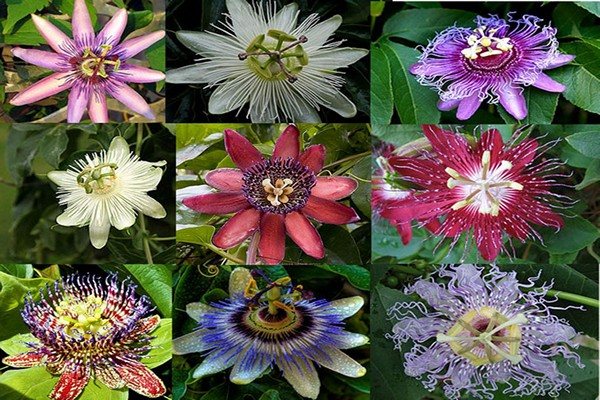

Passionflower incarnate contraindications. Passiflora Incarnata - Frequently Asked Questions
- Can Passiflora Incarnata be used for opium withdrawal and insomnia?
Yes, opium withdrawal and insomnia are among the most common reported uses for Passiflora Incarnata. Please do not use Passiflora Incarnata for opium withdrawal and insomnia without consulting first with your doctor. To find out exactly how other users are using Passiflora Incarnata.
Should I use this product empty stomach, before food or after food?
Users have reported taking Passiflora Incarnata after meals. However, this information may not be appropriate for your specific situation. Please check with your healthcare professional for an appointment schedule to see what other users have to say about the best time to take Passiflora Incarnata.
Is it safe to drive or operate heavy machinery while using this product?
If you experience drowsiness, dizziness, hypotension, or headache while taking Passiflora Incarnata, then you may need to give up driving and heavy industrial equipment. You should stop driving if taking the drug makes you drowsy, dizzy, or hypotensive. Doctors recommend to stop drinking alcohol with such drugs, because alcohol significantly increases side effects and drowsiness. Please check your body's response when taking Passiflora Incarnata. Be sure to contact your healthcare professional for advice based on your body and overall health.
Is this medication (product) addictive or addictive?
Most drugs are not addictive or addictive. In most cases, the government classifies drugs that can be addictive as controlled dispensing drugs. For example, the H or X chart in India and the II-V chart in the USA. Please review the information on the drug packaging to make sure this drug is not a controlled drug. Also, do not self-medicate or train your body to medication without consulting your healthcare professional.
Can I stop using this product immediately or do I need to slowly withdraw from its use?
Some medications need to be stopped gradually because of the recovery effect. Be sure to contact your healthcare professional for advice based on your body, general health, and other medications you are taking.
Fertile soil
If you use briquettes, then the soil is absolutely ready and needs only a little loosening and moderate moisture. Growing in such a soil is less troublesome, since the soil is completely ready for growing and does not need any manipulation. But if you decide to go the traditional way and create the necessary conditions on your own, then there are many options that can be used to prepare the soil. The passionfruit plant is not very whimsical and it is believed that it is ready to germinate in a flower substrate or in soil brought from the forest, so how its natural cultivation takes place in a forest area. But experienced gardeners adhere to the subjective method and try to grow passion fruit in specially prepared, own hand-made soil, which consists of equal shares of peat and sod land.
Interesting facts about passionflower
- Passionflower has medicinal properties that have been known for a long time. Even the Indians learned to use them for their own good. They used the plant as a laxative, healed diseases of the liver and eyes.
- In the 16th century, passionflower was one of the first flowers to come to Europe from South America.
- Medicines “are made on the basis of passionflower extract.
- Edible fruits produce about 60 species of passionflower. Popular among them are passionfruit, passion flower blue, banana passionfruit, sweet granadilla, giant granadilla.
- Passion flower leaves and roots are used to treat hysteria, epilepsy and insomnia.
- Passionflower is consumed as a tea.
- Dried passionflower leaves can be used like cigarettes.
Who is contraindicated for passionflower
A strict contraindication is an individual hypersensitivity reaction. When applied topically, the oil is known to irritate the skin in some people. Some people may be allergic to Passiflora plants, so they should avoid such foods in any form.
Overall, relatively little information is available on the safety of passionflower as a cosmetic ingredient. Its oil should not be taken internally as it can be toxic even at low concentrations.
Before applying this oil, a patch test should be performed on a small area on the skin. If no irritation occurs, it is safe to apply this oil directly to the skin, even undiluted. However, for problems such as psoriasis and eczema, this product is not recommended for use.
Although passionflower oil is sometimes marketed as an acne treatment, there is evidence that this oil leads to acne formation.
It is also believed that passionflower oil may be comedogenic. Thus, people with acne or problem skin should look for alternative skin care products.
Passionflower medicinal properties
Passionflower is known as a mild sedative. Due to this effect, it is widely used as a sleep medicine and belongs to the herbs that are good at relieving feelings of anxiety and anxiety. Compared to other drugs, its effect on the body is mild and does not have a strong side effect. It has passionflower and other medicinal and beneficial properties.
Passionflower or passion flower belongs to the genus of the passionflower family, which has about 500 species. Most of the plants of this genus grow in subtropical climates, most of all in Latin America.
Some passionflower species are grown solely for the beauty of their flowers. This plant can become a real garden decoration. Other types are for the production of medicines and as a food crop. The most famous is passionfruit or purple Granadilla. Passion fruit is also used for medicinal purposes.
The fruits of passionflower Incarnata, it is meat-red, red-white, flesh-colored, is also edible. Another name for passionflower is a cavalry star or passion flower.
For the preparation of decoctions of this plant, all aerial parts are used with the exception of the fruits.
Passionflower is widely used in traditional medicine. For example, the Indians of Peru used a passionflower called "bat" for liver disease. Passionflower is also used in official medicine. On its basis, the well-known drug Novo-Passit is prepared. Passion flower extract is used in the food industry and for flavoring beverages.
Passion flower composition
Passionflower contains flavonoids, glycosides, phenolic compounds, amino acids. The plant also contains organic acids:
- Formic
- Oil
- Linoleic
- Linolenic
- Apple
- Myristic
- Oleinovaya
- Palmitic
The healing properties of passionflower
Recently, pharmaceutical companies have also paid attention to the medicinal properties of passionflower. From a medicinal point of view, passionflower has the following medicinal properties:
- Antibacterial
- Antifungal
- Pain relievers
- Sedative
- Antispasmodic
It has passion flower and anxiolytic properties, thanks to which it is traditionally used to reduce anxiety, agitation, nervousness, unreasonable fear, sleep disturbances, and convulsions.
Recent scientific studies have confirmed the possibility of using drugs with passionflower for diseases such as attention deficit hyperactivity disorder (ADHD), hysteria, bronchial asthma, high blood pressure, gastrointestinal disorders, fibromyalgia, muscle spasms, hemorrhoids, burns, various inflammations ...
Passionflower is used to relieve symptoms associated with drug and alcohol addiction treatment.
Due to its antispasmodic and mild sedative effect, passionflower can be taken for menstrual cramps or to relieve headaches. This herb is also able to relieve toothache.
Unlike conventional drugs, which are prescribed for fear, nervousness, anxiety, passionflower acts gently, without causing drowsiness and side effects the next day after taking.
As shown by some studies, the intake of passionflower during menopause in the third week of admission has reduced the symptoms that accompany women during this period. It can become a natural antidepressant for women who, for whatever reason, do not want to take hormones during this period.
How to use passionflower
Passionflower can be used in the form of decoctions, tea, alcoholic tincture. Here are the most common ways to prepare and consume.
From anxiety and worry
Passionflower has long been known for its soothing properties. It contains alkaloids that help reduce the amount of monoamine oxidase. This in turn helps in the treatment of anxiety, depression and nervous anxiety.
To reduce these symptoms, brew tea by pouring one tablespoon of dried passionflower leaves with a glass of boiling water and leave for 7 to 10 minutes. You can brew passionflower in sachets, one sachet per glass of water.
Sleep disorder
Passionflower is believed to help increase the levels of a gamma-aminobutyric amino acid in the brain, which acts as a neurotransmitter. Increased levels of this acid in the brain make a person calmer and more relaxed by reducing the production of neurotransmitters that cause anxiety and sleep disturbance.
For insomnia, it is recommended to drink a cup of passionflower tea an hour before bedtime. Brew in the same way as in the previous recipe.
Read on: What herbs to drink for insomnia
As an anti-inflammatory agent
A brewed tea bag with passionflower can be applied to a burn, inflammation, or where there is pain. This will help reduce pain and discomfort. Brew a bag of passionflower tea for five minutes and apply warm to the affected area for 10-15 minutes two or three times a day.
For gastrointestinal disorders
Passion flower tea is an effective natural remedy for stomach and intestinal problems. At the first sign of stomach or intestinal discomfort, drink a cup of passion flower herbal tea twice a day. If stomach pain persists within three days, seek medical advice to avoid major problems.
High blood pressure
For those who do not have very high blood pressure, drink a cup of tea with passionflower a day. Do not drink tea with passionflower at the same time and take medications to lower blood pressure, so as not to lower it to a dangerously low level.
You can take herbal tea, which, in addition to passionflower, includes peppermint and lemon balm. Pour a tablespoon of the collection with a glass of hot water and leave for 15-20 minutes.
This infusion is taken 1/3 cup three times or in small sips during the day.
Such decoctions and tea can be drunk with neurasthenia, heart neurosis, climacteric disorders, atrial fibrillation.
For the treatment of alcoholism
For this purpose, fresh leaves of the plant are used. Brew one or two leaves with 200 ml of boiling water and leave for 15 minutes. Take the resulting broth in small sips throughout the day.
Passion flower tincture
At home, you can make a tincture. It is prepared in the same way as other alcoholic tinctures. To prepare 2 tablespoons of dry herbs, pour 110 ml of vodka and insist in a dark place for 2 weeks. Then filtered and stored in a cool, dark place.
You need to take the tincture from 20 to 40 drops 3 times during the day, diluted with a little water.
Passionflower for children
Passionflower is a safe herbal remedy for children and adolescents. It can be used to maintain restful sleep, slight muscle twitching in a child, and nervousness. Be sure to consult a doctor before use.
Contraindications and side effects
It is generally safe to use Passion Flower formulations in moderation. It should be taken no more than two months. Then be sure to take a break for two or three weeks. And only then can the reception be resumed again.
Some side effects may include:
- Dizziness
- Confusion of consciousness
- Change in consciousness
- Nausea
- Vomiting
- Drowsiness
Heart rhythm failure when taken in high doses and over a long period.
If you notice these symptoms, stop taking the drug immediately and see your doctor.
Passionflower is not recommended during pregnancy, as it contains substances that can cause the uterus to contract.
You should not drink passionflower and preparations with it while breastfeeding, as there is no scientific evidence on its effect on a child and how safe it is for infants.
Do not take passionflower while taking medications for high blood pressure and antidepressants.
It is forbidden to take drugs with passionflower before surgery or research using anesthesia.
Passionflower should be avoided by people who have a tendency to have low blood pressure, as the antihypertensive activity of passionflower can lower blood pressure levels to dangerously low levels.
Multiple cups of passionflower infusion or tea may cause drowsiness.
Passion flower extract can inhibit blood clotting. This may not be entirely dangerous for people who have a tendency to form blood clots, but it is dangerous for people with normal blood clotting, as it can lead to hemorrhage.
Preparations with passionflower and where to buy
Passiflora formulations are available in several forms. They can be bought in the form of tablets, capsules, liquid extract. The herb of the plant is sold in tea bags or in bulk. The price depends on the form of release, manufacturer and place of sale. But, in general, it is not high.
You can buy these drugs in a regular or homeopathic pharmacy, or order them online.
The most famous are such companies that produce drugs with passionflower: this is Edas Holding OJSC.
The most famous drug with passionflower is Novo-Passit. In addition to passionflower, it contains other herbs with sedative properties.
The Finnish company produces the drug "Unisin", which is also recommended for sleep disorders, anxiety, anxiety, and increased fatigue. Together with passionflower, it includes other medicinal herbs: hop cones and lemon balm.
In all these preparations, passionflower Incarnate is used. It is this type of passionflower that is most popular and most useful in terms of medicinal properties for health.
See how beautiful passionflower is. Her beauty is mesmerizing
How passionflower blooms
Passion flower in nature and at home
This plant is also known as grenadilla, lilikoi, peshenfruit, passionfruit, sweet bowl, passion flower, cavalier's star and marquise. It came to us from South American countries. Most actively grown in Sri Lanka, Australia, New Zealand and Israel. Under natural conditions, this plant is a perennial woody vine. With its specific antennae, it clings and winds along the walls, along the trunks of trees. Climbing in this way, passionflower rises to a height of ten meters.
To protect itself from the rays of the scorching sun, the vine hides under a dense canopy of moist jungle vegetation. Hanging from trees, it creates dense thickets. Of the 400 plant species, the most popular is the edible passionflower.
Where to buy and how to choose
Yellow passionfruit is more commonly found in supermarkets as a juice. However, the purple variety is more commonly found in stores and is preferred by many for its flavor. Shop for well-ripened fruits that are large and heavy for their size. If the passionfruit is heavy, it means there is a lot of moisture inside and the pulp is juicy.
Ripe fruits have thick, wrinkled rind and are more aromatic and sweeter. This applies to both the common purple species and the yellow-green. A smooth skin indicates that the passionfruit is not yet ripe.
Avoid overripe fruits. Slight cracks and spots on the skins of passionfruit are normal. Such small abrasions on the surface usually do not affect the quality of the fruit.
Do not use passionfruit if it has dry, wrinkled, or badly damaged skin.
Dosage forms
Tincture it is recommended to cook with 60% alcohol. For 1 liter of alcohol, take 200 g of dry passionflower herb. Insist in a glass container, shaking occasionally, for 2 weeks. Take 30-40 drops 3 times a day.
It's very good to use her in fees... For example, 20 g of passionflower herb, 10 g of lemon balm leaf or herb, 10 g of mint leaf, 15 g of anise fruit, 25 g of valerian root. 1 tbsp. spoon in a glass of boiling water, taking 1/3 cup 3 times a day.
How and with what there is a "fruit of passion"
Most often, the fruit is consumed fresh. Before taking it, it must be washed and cut in half. It is convenient to eat the pulp with a teaspoon. Granadilla contains black seeds that are easy to cut and can be eaten.
Granadilla pudding
Dessert is suitable for breakfast and as a dish for a candy bar.


Step-by-step cooking technology:
- Cut open the granadilla and extract the pulp.
- Grate the lime zest and squeeze the juice from the inside.
- Separate the yolks from the whites and mix them with 60 g of sugar, whisk thoroughly.
- Add milk, butter, flour and baking powder, continuing to stir until smooth.
- Beat the whites with the remaining sugar until thick foam, pour lime juice into the mixture.
- Mix the protein mass with the egg yolks in one container.
- Place in small tins and bake in the oven at 180C for 30 minutes.
Garnish the pudding with mint and granadilla pulp before serving.
Passion Fruit can be used in passion fruit recipes.
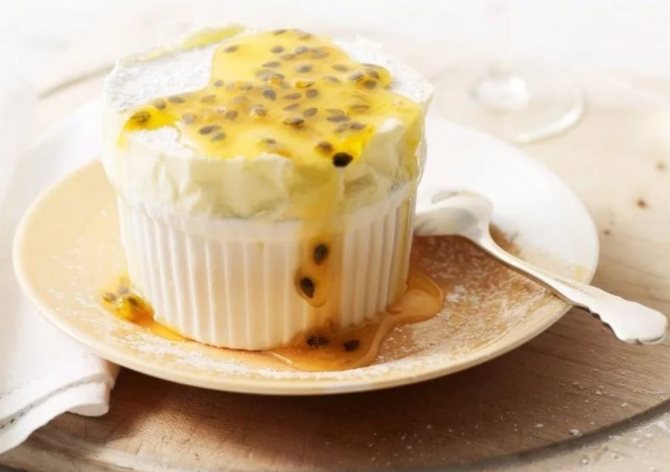

The top layer of the pudding can be jelly made from juice and granadilla seeds.

